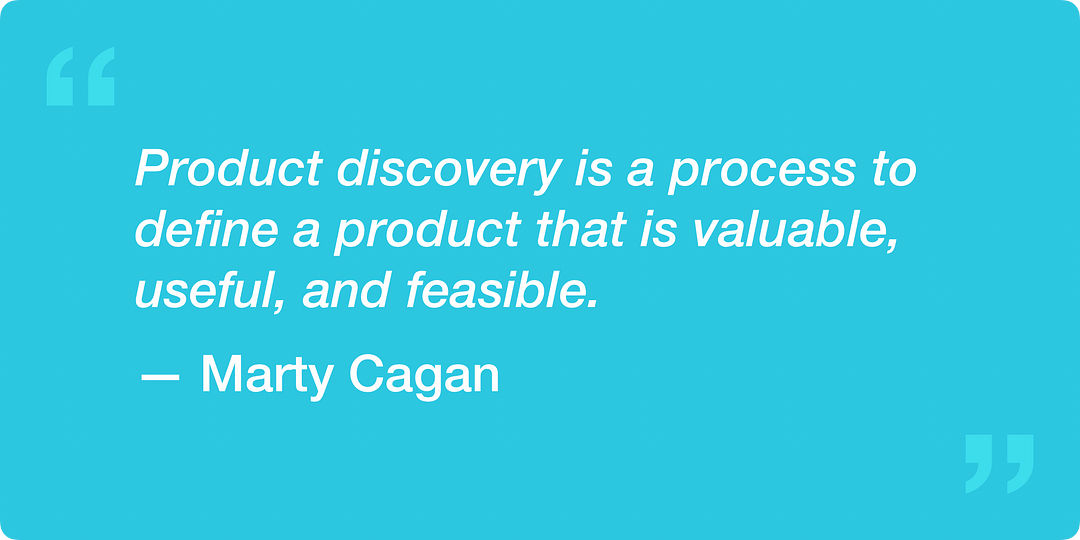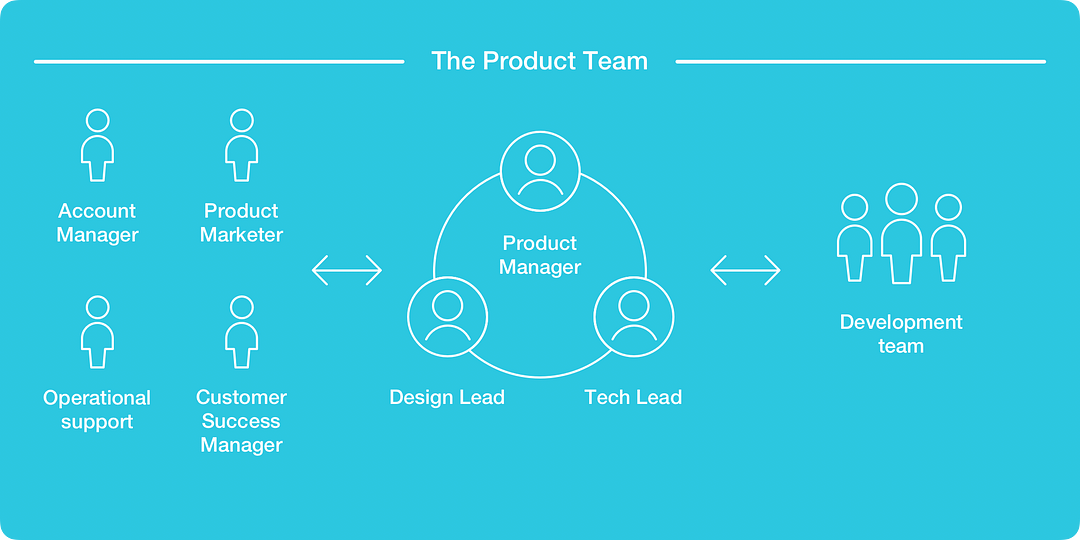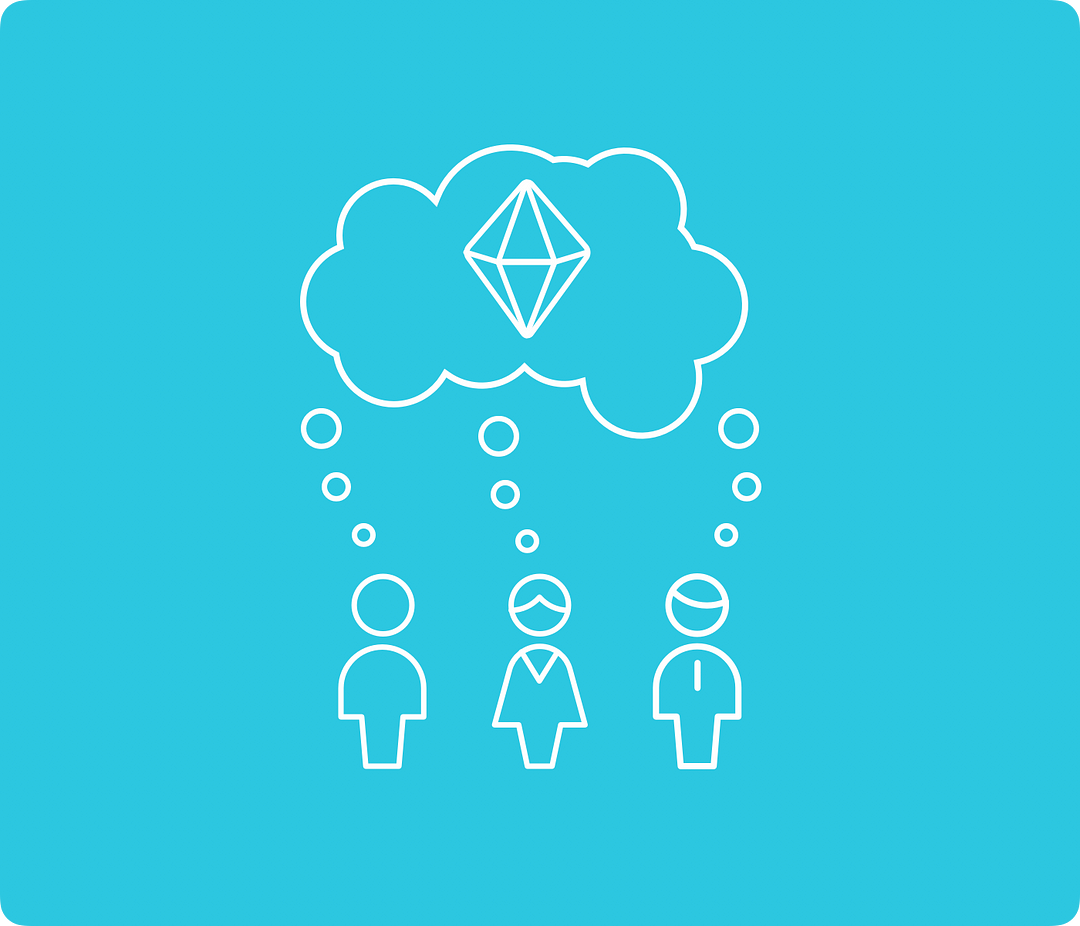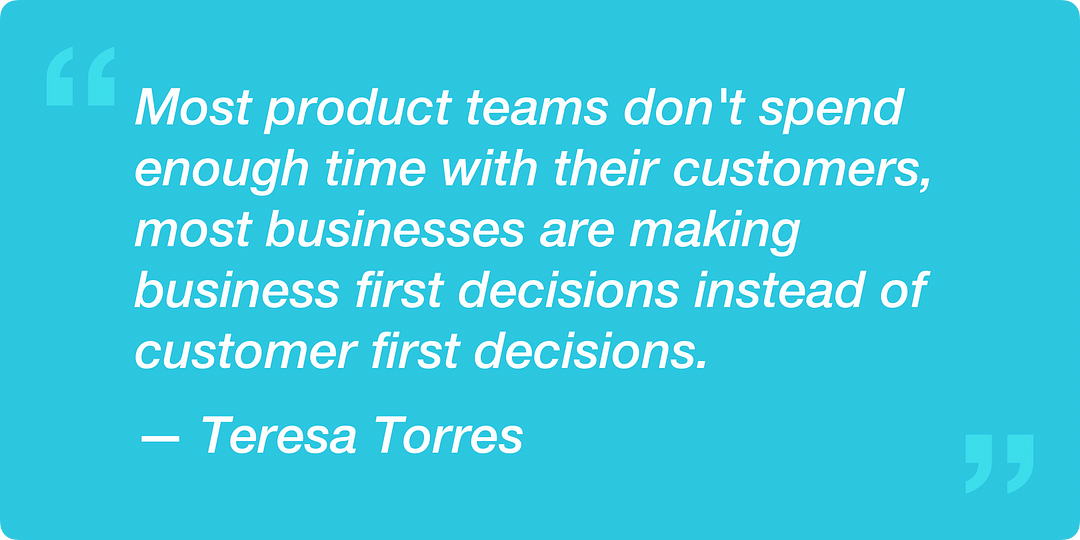Scaled products are past the stages of early access, or pre-launch, and have grown to have plenty of customers and regular users. With that in mind, let’s explore product discovery for teams who are working on scaled products, or in the process of scaling their product.
Product discovery encompasses all the research and decisions on the product, whether that’s planning your next feature, improving existing functionality, or testing your latest product proposition.
What is product discovery?

“Product discovery is a process to define a product that is valuable, useful, and feasible.” — Marty Cagan
Product discovery enables teams to learn about their users and customers, validate assumptions, and learn what is the right thing to build at the time. These methods are often referred to as design artefacts and they include activities such as problem definition, prototyping, customer interviews, exploration and many more.
This process helps team tackle a problem or an idea, and discover whether it is feasible, desirable and viable. The main phases of product discovery are:
1. Challenge definition A challenge could be responding to customer feedback, introducing a proposition, or overcoming a technical problem. The challenge will need to be clearly defined by the team in order to create a shared understanding, and proceed with the discovery process.
2. Exploration The first step after identifying the problem is to explore what solutions are available:
- What is already available in the market, and what is the product market fit?
- Do your users have a work around for this issue, for example by calling customer service?
- Given time and resources constraints, how can the team offer?
Market research as well as customer interviews will help you learn how others have solved similar challenges. It is important to document & record the outcomes of your research. This could be in the form of presentations, sketches, in a team wiki, workspaces like Slack, or any other format that is easy to share with the rest of the team
3. Finding a solution From the exploration there might be a number of possible ways that could help solve the underlying challenge. As part of the discovery process you will need to choose the one that will work best for your users, and your team.
This is likely to involve both design and technical details. The outcome can be documented as a user flow, storyboard or prototyping, to help visualise and explain the new solution. The technical details will also need to be documented in a form that best works for your team. This could be presented as information architecture, data flow diagram, or even as an acceptance criteria.
4. Prototype, test and validate

Good test kill flawed theories; we remain alive to guess again — Karl Popper
It is important to validate solutions from the discovery process with real users. There are many ways you can test your solutions, this could be by creating design mockups, prototypes, or customer interviews. The test should help you validate the desirability, usability, feasibility, and if it really fixes the problem the team set out to solve.
Validating solutions before they are built saves time & money, as it reduces the cost of development building the wrong thing. The outcomes & feedback of the test should help the team iterate and update the solution, to give your product the best chance for success.
In some cases of product discovery, it is possible to condense a lot of these discovery and customer research activities into an intense workshop known as a design sprint.
How does product discovery work?
Product discovery is lead by a core team, often called a discovery team, consisting of a Product Manager, Product Designer, and Senior engineer (or Solution Architect).
The discovery team should serve a development team. They are responsible for understanding which problems are best & most important to tackle, and when necessary, involve the rest of the development team in order to help solve them.

The discovery team structure, credit Nikki Veldhuis
The discovery team need to align on the problem, how they are going to investigate it and what solution they are aiming for.
To align means to come to a real agreement of what needs to be done as part of discovery. At times, language can be ambiguous and teams may fall in to this trap


How does the discovery team communicate, credit Nikki Veldhuis
The results of the discovery process should be clear work items for the development team to be picked up. This can be in the form of user stories, prototypes, designed visuals and supporting technical documentation suggesting how to implement the work item.
The discovery team has the goal to answer the following questions:
- Will the customer buy this, or choose to use it?
- Can the user figure out how to use it?
- Can we build it?
- Does this solution work for our business?
Focus on being evidence based
To have a successful discovery process the team must collect evidence to support their assumptions. The evidence is gathered during the product discovery with activities such as market research, user interviews and prototype testing.
Do not expect to be right first time
The discovery team should set their expectation that many ideas won’t work, and the ones that do will need some iterations. They need to be open to solve the underlying problem from different perspectives. For example sometimes the design of a solution is too complicated, and it needs to be before taking it further.
Iterate on solutions
The discovery team should be prepared to iterate on a problem several times. It is unlikely the solution will be 100% right the first time, and they should be excited to try out many approaches to solve it.
The iteration that eventually ends up with the development team, is the solution that came out best in testing & validation. These tests should expose problems with the solution before the development stage.
Involve the development team in discovery
The discovery team should ask for help from the developers to help solving challenges. Not all the developers should participate in discovery at once. However those who have a good understanding of the elements involved, should also participate in the discovery process.
This participation creates clarity and understanding, between the discovery team and development team, meaning when a new item is brought to a refinement or planning meeting, the development team is familiar with it, and can help the team’s discussion.
Having developers and QA testers involved in the discovery process also gives the development team a bigger picture of what the organisation is aiming to achieve, what the customers want, and brings accountability to the team to feel responsible for the product. The development team have strong problem solving skills that can be very helpful during discovery.
Developers can anticipate changes the designed solution will need, to make it more flexible in order to incorporate any upcoming features. Sometimes when the development team does not have a wider picture of the business goals they tend to over-engineer and this could decrease the speed of delivery.
The team can also help identify low hanging fruits: features that require low effort but bring a high value.
How is continuous product discovery conducted?

“Most product teams don’t spend enough time with their customers, most businesses are making business first decisions instead of customer first decisions.” — Teresa Torres
Product teams always want to learn more about their users. Therefore the discovery process does not end after launch.
This means continuing all the product discovery work undertook before going live, with additional activities such as data analysis, connecting with operations, and spending time with customers. This way of working will give the team multiple data points for making product based decisions.
Data analysis
Once a product is live, the team can use data analysis tools to learn user trends by tracking events, monitor overall traffic, and views on particular sections of the product.
The data analysis tool should be a key source of learning on user behaviour, and can be used to evaluate changes to the product.
Connecting with business operations
Team members from operations, customer service & sales who interact, or work with customers who use your products are on the front line of communication with users on a daily basis. They are an important source of product feedback, as they will have key insights for the discovery team to learn from.
Having a regular line of communication with business operations, ensures information gets fed directly to the discovery team. This is an opportunity for representatives from business operations to give feedback & discuss upcoming challenges with the discovery team.
This is not only beneficial for the discovery team, it will help the operation side too. Those involved in business operations will become advocates for the product, as they know there is a team supporting them in fulfilling their role. They will have buy-in for the product, as they see how together the two teams are solving real user challenges.
Share learnings
As the product grows and reaches maturity, it’s important to make sure that the knowledge that is gained during product discovery is shared across the company, as it’s likely to affect other parts of the organisation, not just the product team.
By sharing the understanding, grounded in use research, across the company, everyone can learn from your customers and can contribute to that shared understanding.
What are the benefits of continuous product discovery?
With continuous product discovery the product team always has a connection with their users. The learning process does carry on after product launch.
Product discovery brings the right people together to create a shared understanding between members of the product team and the relevant parts of the business. This process allows insights from customers and key stakeholders to be shared easily amongst teams.
This way of working leverages the team’s knowledge and expertise, to tackle difficult problems, find outstanding solutions, and creates support for key product decisions.
- Designers can help in conducting user interviews and building prototypes,
- Developers can advise on technical feasibility, identify technical risks, and research possible solution.
- Account managers can connect the product team with target users and help with competitor research.
- Operations and Customer support managers can give insights in to the pains customers are facing, and how the product is being received in different markets.
Bringing the right people together avoids handoffs that are time-consuming and often ineffective. Capturing all the details learnt in product discovery is hard. By working together the team can identify a problem, explore solutions, test with customers and iterate.
By having a discovery team serving product team, involving development and customer facing roles from the start of the discovery process, handoffs are avoided and key insights less likely to be lost. Learnings can be shared quickly and the right solutions can be identified and delivered fast, to ensure product success, in a cost effective way.
Conclusion
Product discovery involves problem definition, where a discovery team explores solutions to the identified challenge. The solutions are validated with user by using techniques such as prototyping and user interviews.
Do not expect to be right with a solution the first time, be prepared to update on solutions as a response to user testing. Make sure you collect direct customer feedback, gather insight, learn & iterate.
Involving the product team in the discovery process is crucial for success. Use the team’s expertises and insights to learn more about the customer problems, and explore the optimal solutions. Make sure to share learnings from the discovery process with the product team.
Treat product discovery as habit, reporting on and during the process not only on the outcomes. Sharing the insights regularly with the product team and with stakeholders builds confidence in the process and in the outcomes from the team.
How we get to insights is as important as the insights themselves. You want to involve people as you are developing the research. This involves generating updates as the team progresses, including giving short presentations from customer interviews or sharing screen grabs of a testing session.
Documenting the product discovery throughout the different activities, will bring clarity to how the research was conducted and how the decisions were made. It is important to be able to look back at the work completed and understand why certain things were decided, and how the understanding of the problem has evolved.


